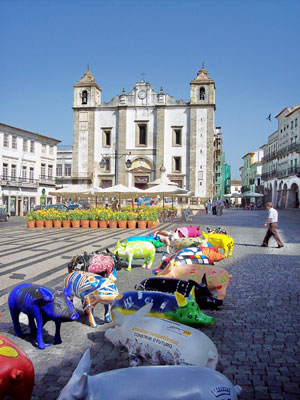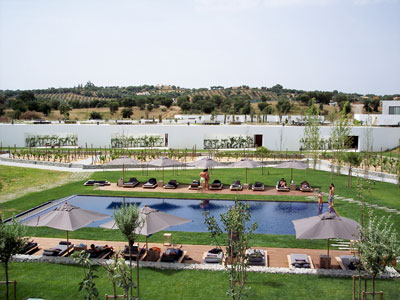Alentejo
This item appears on page 62 of the November 2011 issue.
by Randy Keck (Second of two parts on Portugal)
The focus of my June 2011 journey to Portugal was four inspiring days in the central portion of the country’s largest region, the Alentejo. It was my good fortune to be hosted by the new L’AND Vineyards, only a 45-minute drive east of Lisbon.
L’AND’s setting provides views of the distant, hilltop, 13th-century castle ruins of nearby Montemor-o-novo village and proved to be an idyllic base from which to visit attractions of the region on either a self-drive basis or, as in my case, with a car and driver.
The Alentejo seems to be genuinely held in high regard by all Portuguese. They speak soulfully about its lure, making it seem, at times, as much a state of mind as a place.
It is mother Earth, the comparatively unchanged land of wide, open spaces dotted by farms, vineyards and the ever-present cork trees, which provide much of the world’s supply of cork despite the fact that the precious bark is harvested from each tree only every ninth year.
In much of the Alentejo, the buildings and some entire towns and villages are white in color to help combat the summer extremes of heat, such as those I experienced during my stay.
While touring, I was informed of a recent positive trend: young Portuguese are returning to the land and the rural lifestyle, with many undertaking preparatory education in viticulture and other types of agriculture, particularly in relation to biodiversity and sustainable technology.
Évora
Only a 15-minute drive from L’AND Vineyards is the historic walled city of Évora, resplendent with cultural and architectural influences of its past Roman, medieval and 17th-century occupiers. It is a treasure trove of history, as revealed by a stroll down Rua 5 de Outubro — with colorful craft shops displaying cork and other regional products — to the city’s vibrant main square, Praça do Giraldo.
Évora’s 20 churches and monasteries even include a morbid chapel of bones, which seems to be included on most group-tour itineraries.
I particularly enjoyed the main building (dating to 1559) of the old university, which now is part of the University of Évora. The school retains it impressive cloister and notable azulejos (tiles) depicting educational themes, such as Plato lecturing to disciples (1744-49). I was able to wander the halls undisturbed while students were taking their final exams.
The historic legacy of the city was acknowledged in 1986 when Évora was accorded UNESCO World Heritage Site status. I strongly suggest taking a guided tour, especially if time is limited. I was fortunate in this regard, being led by Gertrudes Alves Alfacinha (e-mail gertrudes alvesalfacinha@hotmail.com), a Renaissance woman and both a local and national guide, whom I most highly recommend.
Herdade do Esporão Winery
My visit to the expansive, 1,834-acre Herdade do Esporão Winery unexpectedly produced the most informative winery tour I have encountered in my travels.
With roots that trace to 1267, Esporão is one of the most highly regarded vintners in Portugal, bottling 23 types of wine of three different standards, 75% of which is red. Quality olive oil is also produced on the estate.
My tour included a detailed history of the property, the winery, several cellars and a bottling operation plus wine tasting.
Esporão is committed to biodiversity and sustainable technology in all of its operations and offers educational programs, among which are jeep and Segway tours of the estate, in addition to the standard winery tour.
Lake Alqueva and Monsaraz
With over 700 miles of almost entirely pristine shoreline, the Alentejo’s newly created Lake Alqueva is the largest man-made lake in Western Europe. Portugal has significant development plans for the lake, with the focus on recreation (including hotels and marinas), agricultural irrigation, general public uses and the generation of hydroelectric power.
My peaceful 1½-hour cruise covered only a tiny corner of the sprawling water mass.
Perched at the top of a hill overlooking the new lake, the tiny 12th-century medieval walled town of Monsaraz is a “must see” for visitors to the region. Its narrow streets lead to a preserved 13th-century castle that provides sweeping vistas over the lake and the frontier with Spain. The castle’s garrison courtyard, on occasion, still serves as a bullring.
Visiting in late afternoon after virtually all tourists had departed, I had the village much to myself, save for a film crew preparing for an evening shoot.
L’AND Vineyards
My four days in residence at L’AND Vineyards (Herdade das Baladas, Estrada Nacional 4, 7050 Montemor-o-novo, Portugal; phone +351 266 242 400) — itself, a destination — proved to be both relaxing and inspiring.
Rows of vines surround and are interwoven throughout the L’AND property, complemented by a serene lake and pool that add a balancing aquatic presence to the landscape. The modern styling of the entire complex emphasizes the use of stone, slate and wood, with a central reception atrium of Roman and Arabic design.
L’AND’s amenities include 22 spacious luxury guest suites, an exceptional courtyard restaurant, both indoor and outdoor pools, a full spa, a wine club and wine production on site.
The L’AND Sky Suites feature retractable ceilings which open to reveal the clear night skies of the Alentejo. Rates run €200-€300 (near $268-$402), double, including breakfast.
The restaurant’s gourmet cuisine features regional seasonal organic offerings amiably influenced by Asian-oriented cuisine, the result of early Portuguese explorations to the Far East.
One of the brothers of the primary developer of L’AND operates an organic farm nearby for the primary purpose of providing employment for local people, in contrast to the standard modern, high-tech agricultural practices which require few employees.
The multifaceted farm is a highly commendable and selfless undertaking, and guests of L’AND Vineyards are invited to visit. The farm encounter was a fitting finale to my time in the Alentejo.
Keck's Beyond the Garden Wall
❝Haunting chants of remembrance
Blended harmonies of hope
Ancient lands where melodious tones
are the eyes to the soul. ❞
— Randy reflecting on the musically endowed Georgians


